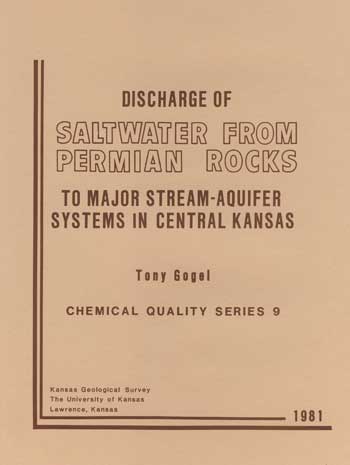Discharge of Saltwater from Permian Rocks to Major Stream-aquifer Systems in Central Kansas
by Tony Gogel

Originally published in 1981 as Kansas Geological Survey Chemical Quality Series 9. Prepared by the Kansas Geological Survey and the U.S. Geological Survey. This is, in general, the original text as published in 1981. The information has not been updated.
Executive Summary
Degradation in chemical quality has made freshwater unsuitable for public use in several areas of central Kansas. The hydrologic conditions that control the flow of saltwater from Permian rocks into overlying freshwater systems are not fully understood.
An Investigation has shown that dissolution of evaporites has formed a salt-water aquifer in the solution cavities and collapsed beds along the eastern edge of the Wellington Formation. The potentiometric surface of the aquifer is highest in the area east of Hutchinson and hydraulic gradients slope northward toward the Smoky Hill River Valley and southeastward toward the Arkansas River valley.
A comparison of well data Indicates several major areas where the potentiometric surface of the saltwater aquifer is higher than the water table of the overlying freshwater aquifer. This difference in hydraulic head causes upward leakage of saline water into freshwater systems. Analyses of seepage-salinity data indicate that about 660 tons of chloride per day are discharged into the Smoky Hill and Arkansas Rivers.
Significance of the saltwater encroachment will continue to increase as the withdrawals of freshwater for municipal, industrial, and irrigation supplies continue to increase. Additional studies are needed to assess the feasibility of various methods for alleviating the contamination and improving the water quality in the Arkansas and Smoky Hill Rivers.
Abstract
Saline-water inflow from Permian rocks has resulted in the degradation of freshwater systems in several areas of central Kansas. Solution of evaporite beds has occurred along the eastern edge of the Wellington Formation, chiefly within the Hutchinson Salt Member and associated gypsum units. The solution, caused by leakage of freshwater primarily from overlying unconsolidated deposits, has resulted in formation of a discontinuous zone of solution cavities and collapsed beds. This zone, which extends southward from Salina to near Wellington, contains large quantities of saltwater and is termed the Wellington aquifer.
The generalized potentiometric surface of the Wellington aquifer is determined from water-level measurements in observation wells and from digital model studies. A ground-water divide is indicated on this surface east of Hutchinson where the gradient slopes northward toward the Smoky Hill River valley and southeastward toward eastern Sumner County in the Arkansas River valley.
The digital model and field evidence indicate that there are several major areas where the potentiometric surface of the Wellington aquifer is above the water table of the overlying freshwater deposits. This difference in head provides a mechanism for the upward leakage of saline water. Areas of saline-water encroachment to freshwater systems are near Belle Plaine, Adamsville, and Geuda Springs in south-central Kansas and in the Smoky Hill River valley east of Salina. Another area of possible saline-water contamination is southeast of Hutchinson. Owing to erosion of most of the intervening shale layers, the Wellington aquifer may be in hydraulic connection with the aquifer in the unconsolidated deposits.
Regression analyses and measurements of seepage and salinity were used to determine the amount of saltwater discharge and chloride-load increase to the Arkansas River and its tributaries between Derby and Arkansas City during 1970-74. These analyses indicate that approximately 0.60 cubic foot per second of saltwater is entering the freshwater system in this area and that the average increase in chloride load is about 294 tons per day.
Possible methods of alleviating saline-water intrusion include desalinization, dilution, evaporation, and diversion. Interception may be accomplished by installation of wells in the Wellington aquifer or at the base of the unconsolidated deposits or by construction of collection systems at land surface in areas of seeps and springs. Following interception, possible methods of saline-water disposal include: (1) injection into the Arbuckle Group of Cambrian and Ordovician age, (2) dilution with freshwater in streams during high-flows, or (3) evaporation from surface ponds.
Kansas Geological Survey, Geology
Placed on web Jan. 2006; originally published 1981.
Comments to webadmin@kgs.ku.edu
The URL for this page is http://www.kgs.ku.edu/Publications/Bulletins/CQS9/index.html